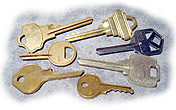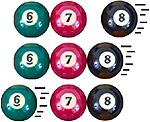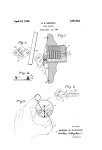|
 |
| What is a bump key? |
|
|
 |
 A bump key is a new threat to everyone's security. The locks you have on your front door are probably vulnerable to a bump key. Basically, a bump key is made by taking any regular key and modifying it with some common household tools. After that, it will open most locks that the key can physically slide into. For example, your home may have a Kwikset®, Schlage®, or Baldwin® lock on it. If someone made a Kwikset® and Schlage® bump keys they would probably be able to open your door very easily. A bump key is a new threat to everyone's security. The locks you have on your front door are probably vulnerable to a bump key. Basically, a bump key is made by taking any regular key and modifying it with some common household tools. After that, it will open most locks that the key can physically slide into. For example, your home may have a Kwikset®, Schlage®, or Baldwin® lock on it. If someone made a Kwikset® and Schlage® bump keys they would probably be able to open your door very easily.

How does the bump key work?
 The bump key works on basic physics. Imagine a set of 3 billiard balls on a pool table, all touching each other. When you tap the first ball with the cue ball, what happens? The last ball moves away. The bump key works on the same principal. When the bump key is inserted into the lock, and then tapped on with a small hammer, the impact of the hammer travels through the key, into the bottom pins in the lock, and then to the top pins in the lock. Since the top pins are only supported by springs, the springs compress and the top pins "jump" for a fraction of a second. It is within that short timeframe that the lock can be opened. Although it might sound complicated in theory, in reality it's very easy. The bump key works on basic physics. Imagine a set of 3 billiard balls on a pool table, all touching each other. When you tap the first ball with the cue ball, what happens? The last ball moves away. The bump key works on the same principal. When the bump key is inserted into the lock, and then tapped on with a small hammer, the impact of the hammer travels through the key, into the bottom pins in the lock, and then to the top pins in the lock. Since the top pins are only supported by springs, the springs compress and the top pins "jump" for a fraction of a second. It is within that short timeframe that the lock can be opened. Although it might sound complicated in theory, in reality it's very easy.


How easy is it to use a bump key?
Video sharing websites like youtube.com and video.google.com have videos of young men demonstrating their bump key abilities, and how easy it really is. Although they are showing themselves opening their own front door, think of the countless many that have learned how to use a bump key and decided it would be "fun" to open their neighbor or friend's doors? Many of them do not know the consequences of a breaking-and-entering crime.
Why is the bump key such a threat?
The bump key is quite the burglary tool -- it can be made easily, is made from any key (not just keyblanks), and the instructions are all over the internet on how to make and use this burglary tool. Unfortunately, they are also easily available online and from auction sites. Generally lockpicks and other locksmith tools are difficult to obtain and use, the bump key is easy to make and requires very little skill to use.
| What locks are vulnerable to a bump key? |
Literally millions of locks all over the world are vulnerable. Virtually all keyed locks sold in common hardware stores can be opened with either a KW10 Kwikset ® or an SC4 Schlage ® bump key. This includes, but it not limited to, Kwikset ® standard and Maximum Security locks, Schlage ® commercial and residential, Baldwin ®, Pegasus ®, Brinks ®, Defiant ®, Defense ®, Yale ®, Master ®, and many other brands that are imported versions of the standard pin-tumbler design. Deadbolts, knobsets, leversets, rim cylinders, mortise cylinders, and most padlocks are also vulnerable to this attack. For example, Master ®, Brinks ®, and American ® padlocks have been opened with bump keys.  When the packaging for a lock includes phrases like "Extreme Security, High Security, Pick-Resistant Pins, ANSI Grade 2" or even my favorite "The Best Security You Can Buy", it does not necessarily mean the lock is bump-proof. Basically, if you bought your lock from a hardware store it's probably vulnerable to a bump key attack. In a twist of irony, the more expensive the lock, the easier it opens with a bump key. The reason behind that is that the better locks are machined to tighter tolerances for better fitting components, and there is little room for wasted energy. Basically, the bumping energy transfers more efficiently. Most locks purchased from locksmiths are also vulnerable. If you did not specifically purchase a high security lock from a locksmith, it is probably vulnerable. |

What is the solution?
For doors that are less frequently used (doors on the sides of garages for example) you can purchase a solid slide bolt lock that would prevent the door from opening from the outside. Of course, the solution for the door that you use to exit your home or business is to replace your current lock with a high-security lock. High security locks provide additional layers of protection against picking, drilling, and of course bumping. Each of the manufacturers that we represent has built in their own technology that thwart the bump key's effectiveness, and also offer drill protection, extreme pick resistance, and key control. To learn more about the products, click on the product category links on the left panel.

The bump key threat is real, and the thieves have known about this for years. After reading this document you will know too.
Bump keys have been around for almost 80 years

Thanks to the U.S. Patent Office, there is proof of the existence of bump keys way back in 1928, although they were not called bump keys at that time. Mr. Hiram R. Simpson filed U.S. Patent #1,667,223 for a lock picking device that operated on the same principle as the bump key. Click on the thumbnails to view the full size images of the patent filing.
  
To learn more, here are some additional links about bump keys:

My comprehensive eBay Guide regarding bump keys and high security

Newsweek Article on lock bumping, August 2nd 2006

Medeco Press Release on Bump Keys

Additional Information on the bump key from Bay Area Locks

Bump Keys in the Media

Engadget Article by Marc Tobias of Security.org

Wikipedia Entry for bump keys

Snopes Report (urban legends and myths)







Bump Keys on Ebay are still easy for anyone to get. Even though E-Bay considers them prohibited items, they still show up as "depth keys". Searching any bump key forum on the internet will reveal this secret.


All product names are trade names or trademarks of their respective owners.
|
|
 |
|
|

